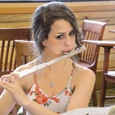Every place I go, I see flutists carrying an orchestral excerpt book because these excerpts are now on audition lists for university music schools and even many youth orchestras. After I hear the youth orchestra in concert, however, I wonder why their auditions require excerpts like the flute variation from Stravinsky’s Firebird Suite or the solo in Hindemith’s Symphonic Metamorphosis when there is no chance that this ensemble could or should play these compositions. For some reason, however, they continue to ask for the most difficult excerpts on the audition lists. University programs with modest orchestral resources also require this repertoire. Then there are the students who only want to study excerpts at lessons, yet have a little understanding of flute fundamentals or basic musicianship skills. In each of these cases, we have this picture wrong. It is like requiring a novice cook to decorate a multi-tiered wedding cake before he has learned to make a cake from a box mix. We need to take baby steps before leaping into the most difficult excerpts in the orchestral literature.
Duets
Before students can play difficult excerpts, they should learn to count accurately and play in a steady rhythm with the appropriate tone and dynamics. Duets are an excellent way to practice these concepts. Assign students a duet partner and schedule weekly practice sessions. There are numerous excellent duet books to choose from, but I would suggest choosing one that contains duets written in the Baroque and Classical styles and progress from an easy to advanced level.
Before students start a work, they should discuss the 15 questions in the sidebar below. These are basic, fairly obvious questions that any flutist should ask before playing a piece, and yet flutists regularly skip this step. How often have you heard a masterclass teacher ask a student to share information about the composer and music they are about to perform, and the flutist can say very little? Often he cannot even place the composer in the correct style period.
The duet should be played through twice, so each flutist gets the opportunity to play both the first and the second parts. Skilled orchestral players know the accompaniment part is often more challenging than the melody. Students will benefit from occasionally playing with a metronome. Have the students practice cueing and looking at one another at important places, including entrances, dynamic changes, cut-offs, fermatas, and grand pauses. They will use this valuable skill in orchestra to look up at the conductor while continuing to play. If students struggle with cueing, video record the duet session so they can observe the signals they give and determine how to improve them. They should also regularly audio record the duet sessions to check for tone quality, balance, consistency of tempo, dynamic contrasts and ensemble issues.
After the students have completed several books of duets successfully, they can explore the canonic writing. (A few options might include, Six Canonic Sonatas, Op. 5, Georg Philip Telemann, multiple publications, Six Canonic Sonatas, Thom Ritter George, Southern Music Company, and Sonatine, Paul Hindemith, Schott). The object of this literature is to teach students to echo the playing of another in nuance, tone color, note length, phrasing gestures, intonation, etc.
First the two flutists should practice in unison until they sound like one flutist playing. Then ask them to repeat playing in canon. If three flutists work together, then try the Canon in D by Pachelbel, playing in unison before dividing into parts. Have the students continue using audio and video equipment to assess their progress.
Kuhlau, called the Beethoven of the flute, wrote several volumes of duets, each containing three multi-movement duos. I suggest flutists learn the duos in this order: Op. 10, 80, 81, 39, 87, 102, (multiple publishers). The Kuhlau duos are an excellent source for learning the standard compositional forms of the Classical and Romantic eras. These forms are: sonata form, ABA, theme and variations, sonata-rondo, and rondo. Before students can learn and perform the symphonies of Haydn, Mozart and Beethoven, they should master these forms. I bought five or six copies of each of the Kuhlau Duos, so my flute choir could explore this repertoire with eight to ten players on each part. It is best to buy the same edition when buying multiple copies so the rehearsal letters or numbers are consistent in all parts.
Only when a flutist can easily and accurately sightread the Kuhlau Duos is it time to begin more difficult orchestral music. Many students have the opportunity to perform with a flute choir, high school orchestra or community youth symphony. If these opportunities are not available, another option is to obtain a full flute part and a CD of a musical performance.
There are several options for obtaining full flute parts for orchestral works. Many college, community and professional orchestras rent or purchase music that is in the public domain from a source such as Lucks Music (www.lucksmusic.com) or Kalmus Music (www.kalmus.com). While both companies deal primarily in complete sets of orchestra parts, they do have a provision for selling individual parts. Generally these parts run between $2 and $5 each. Compositions that are still under copyright are on a rental basis only, so unless you want to rent the complete orchestral set of parts, the single parts are currently unavailable for the individual flutist. For convenience, several flute stores have bundled groupings of orchestral parts together and have them available for purchase for approximately $10 a set.
The Orchestra Musician’s CD-ROM Library has 12 volumes of symphonic masterworks available for purchase. Each volume contains the complete flute parts (Flute 1, 2, (3), (4), piccolo, (alto) etc.) for about 90 works spanning from the Baroque masterpieces through works by Debussy, Ravel, Mahler and Elgar. All the editions are in public domain, so you may print off as many parts as you need, as many times as you wish. These CD-ROMs are available for purchase online at most music and flute specialty stores.
Free parts may also be downloaded from the International Music Score Library Project (www.imslp.org). This project includes the works of 6,344 composers that are in the public domain. From this source you may also download the complete orchestral score which can be used for additional reference and study.
When learning excerpts it is always good to know what the other instruments are playing, and how the flute part fits into the larger picture. By looking at the full score, a flutist can analyze which note of the chord he is playing. This information is the first tool in learning play in tune in an orchestral setting.
Where to Start
Have the student begin his orchestral study in the Classical Era with the late symphonies of Haydn and Mozart and the early symphonies of Beethoven. The overtures of Mozart and Beethoven are other good options. These symphonies were constructed on a commonly known four-movement structural scheme called a sonata cycle.
Sonata Cycle
In a sonata cycle the first movement is in the tonic key, fast, and in sonata form. The second movement is in a closely related key, slow, and in either sonata form, ABA, theme and variations, or rondo form. The third movement is in the tonic key and most usually is in the minuet and trio format (ABA), while the fourth movement is again in the tonic key, faster than the first movement, and in sonata, sonata-rondo, or rondo form.
The sonata form consists of three sections: the exposition, the development and the recapitulation. There could be an optional slow introduction and a coda (tail) at the end. In the exposition, the composer presents his musical ideas with two contrasting themes. One theme is dramatic and the other lyrical. This section ends with a repeat sign, and most often the repeat is honored. Sometimes composers wrote a first and second ending for the exposition. In the development section, the composer develops or manipulates these themes by using composition techniques such as inversion, modulation, augmentation and diminution. In the recapitulation the composer repeats the exposition with a few minor changes.
Rondo Form
The rondo is either in a five-part (ABABA) or seven-part (ABACABA) format. The five-part form is like a club sandwich: a piece of bread; some meat and cheese; a piece of bread; some more meat and cheese; and finally another piece of bread.
Mark the Part
Students should mark the sections of the form in the flute part. This will help them play along with the CD and identify compositional forms in other works. Students should also mark the phrases and insert breath marks (V) to determine breathing strategies. Another useful exercise is to connect the dots of the note heads to clearly see the contour or shape of each phrase.
There are five shapes that are used consistently in lyrical passages: a mountain, a valley, an ascending line, a descending line, and a gruppetto. Generally the high or low point of the phrase will be a place for some type of inflection such as faster vibrato, playing louder or softer or some added length to a note. As students practice, they should pay carefully attention to all performance and articulation marks. The metronome and the tuner should be used consistently. Have students mark an arrow over notes with intonation problems to show whether the note should be sharper or flatter
The Metronome
There are no metronome markings in Haydn or Mozart symphonies. The metronome was invented around 1812 by Dietrich Nikolaus Winkler, but takes its name “Maelzel Metronome” from Johann Nepomuk Maelzel who copied the device, added the numbers (how many ticks per minute), and patented the object as a metronome. Beethoven was one of the first composers to write metronome markings in his music, but because of the lack of accuracy in the construction of the early metronomes, most conductors think the markings in Beethoven’s music are too fast.
Play with a CD
Once a student is confident in his preparation, he is ready to play-along with a CD. Recorded versions of great orchestral works are readily available. A set of Beethoven’s symphonies may be purchased for less than $20, but students can also borrow them from libraries or download them from an online source. Some of my students download the music to an iPod or laptop computer, but I think the best results are achieved when a flutist plays along with a stereo system. When setting the sound levels, students should duplicate the level of sound that they would experience sitting in the middle of a large orchestra and playing principal flute. If possible, obtain several different performances of a composition, to hear the various tempo and pacing choices that may occur from one conductor or orchestra to the next.
Counting Rests
Many students find that counting rests accurately is one of the most difficult things to do when starting this project. This is particularly true when playing with a CD because in a live orchestral setting the flutist is cued by the conductor and perhaps other members of the woodwind section. However, learning to count rests with a recording develops the ears. If a student has repeated problems with an entrance, help him study the full score and write cues in the flute part.
Many novice players see a rest and immediately abandon their concentration. Then they are lost. When the student encounters a rest, teach him to become even more engaged. A rest is not a signal to zone out, but one to zone in. It takes concentration to play accurately and playing with a CD perfectly will help the flutist achieve his goals.
Students should develop a system for counting rests. For example, I always start counting by having my left thumb touch my left little finger for the first measure, then the next finger for the second measure, the middle finger for the third measure and so on. In an orchestral flute section, the principal player usually slightly lifts his left hand at the beginning of a printed rest number (i.e. lift, 8 measures rest, lift, eight measures rest) and at markings like “letter A”. This gesture indicates to the rest of the flute section where the count is and assures that the section is counting accurately together. Often the principal oboe joins in this small gesture. This safety net has saved the day many times when something goes astray during the rests, because at least the flutes and the oboes will be together when they enter next.
Listen with the Score
Several times during the study of the symphony, students should listen to a recording while studying a full score. If a musicians understands what is happening in the composition as a whole, he will be better able to play his part. It is difficult to play a part appropriately if you do not know whether it is a solo or supporting line, or who else is playing at the same time.
What to Do Next
Once the student has learned the symphonies, overtures and accompanying concertos by Haydn, Mozart and Beethoven, repeat this procedure with the great symphonies of the Romantic era. This includes works by Schubert, von Weber, Chopin, Liszt, Mendel-ssohn, Berlioz, Schumann, Franck, Verdi, Brahms, Tchaikovsky, Faure, Dvorak, Mussorgsky, Borodin, Rimsky-Korsakoff, Rachmaninoff, Puccini, Wagner, Grieg, Elgar, R. Strauss, Mahler, Sibelius and Impressionists Debussy and Ravel before moving on to the 20th century composers.
As students move through the list of composers, they will encounter many of the excerpts found in orchestral excerpt books. However, continue to go through the same steps as this will give your students an advantage in learning these difficult solos over those who just learn from excerpt books. They will see how the solo relates to the whole piece. Remind them to take the time to answer the 15 questions from the sidebar before they start a new work. Once students have done their homework and learned the flute music from a complete part, then it is fine to carry around an orchestral excerpt book for convenience sake.
During my career as an orchestral player, I have seen many musicians win an audition because they played the excerpts better than anyone else. Often this person later was not granted tenure in the orchestra because he could not play the rest of the part. I think it is better to learn to be a great ensemble partner first and a soloist second.
***
Questions to Ask Before Playing
•Who was the composer?
•When did he live?
•What is the style? (Baroque, Classical, Romantic, Contem-porary)
•What performance practices are employed?
•What kind of flute would this music originally have been played upon?
•What is the title of the composition? Is this music dancing music or singing music?
•What is the tempo marking? Are there additional tempo markings in the piece? What are the key and time signatures?
•Scan the page for expression and dynamic markings. Look up unfamiliar words.
•Scan the page for any unfamiliar rhythms or counting challenges. Practice rhythmic reading the passage before playing the passage.
•Scan for repeat signs, da capo and dal segno markings. Always know where you are going.
•Are the phrase lengths symmetrical or asymmetrical? Are the notes conjunct (stepwise) or disjunct (skipping). Are there any unusual articulation or performance marks?
•Is the harmony tonal or atonal?
•What is the texture? Homo-phonic (melody with accompaniment) or polyphonic (round, fugue)?
•Which part is more important, the first or the second part? Who has the melody?
The Classical Style
•Haydn worked in the patronage system (supported by a wealthy patron or the church), while Mozart and Beethoven struggled to become free-lance composers.
•The symphony, solo concerto, sonata, and string quartet were the favored compositional genres.
•Movements were constructed in sonata, ABA, theme & variation, sonata-rondo and rondo forms.
•Melodies were triadic and simple. Phrase length was balanced and proportional. Folk songs were employed in rondo movements. There was some use of ornamentation.
•There was slower harmonic movement. Composers used both major and minor, but major tonalities prevailed. Chords with roots a fifth apart were favored (tonic/dominant and secondary dominants). Modulation went to closely related keys.
•Most music was homophonic (melody with accompaniment).
•Dynamics were usually pp, p, mp, mf, f, ff with sfz
•There was some use of silence (G. P.= grand pause)
•Tempo markings were in Italian and had few qualifiers.
•Meter was metrical and consistently – either simple meter or compound meter.
•Rhythm was steady and easily felt. Folk dance rhythms were employed.
•There were about 40 musicians in the Classical orchestra.






